Pocket-size camcorders have become very popular -- so easy to carry and simple to use, so you can bring them along to capture spontaneous moments that wouldn't be possible with larger camcorders.
 You can find pocket camcorders for around $80 to $100, and HD versions for around $150 to $220, with products like the Pure Digital Flip, RCA Small Wonder, Creative Vado, Kodak Zi6/Zx1, and Sony Webbie.
You can find pocket camcorders for around $80 to $100, and HD versions for around $150 to $220, with products like the Pure Digital Flip, RCA Small Wonder, Creative Vado, Kodak Zi6/Zx1, and Sony Webbie.
These pocket camcorders share a similar design -- a rectangular box, held upright with the lens on the flat front and the display on the back. And they share a similar design philosophy, focused on making them dead easy to use by eliminating options and features -- including favorites like optical zoom, multiple video formats/resolutions, still photo mode, and nested menus of sometimes incomprehensible options.
But sometimes it's handy to have at least some options, so these companies have introduced slightly more upscale versions of these products with various features including a flip-out display, video modes (SD, HD, and Web), photos with macro mode, and high-speed recording.
Another company, DXG USA, has taken a different approach: offering a broad line of pocketable camcorders, with a broad range of advanced features, but in this same price range. (DXG has a 20-year history designing camcorders and cameras for OEM sales to other manufacturers, and has recently expanded into direct retail sales in the U.S.)
The DXG camcorder line includes standard-definition and high-def camcorders, with models that shoot at the minimum 720p HD res (1280 x 720), at the lower 1080p horizontal resolution (1440 x 1080), and at full HD 1080p (1920 x 1080).
 In addition, DXG offers pairs of similar models in your choice of form factor: vertical (with the lens on the side and a flip-out display), and horizontal (like traditional camcorders).
In addition, DXG offers pairs of similar models in your choice of form factor: vertical (with the lens on the side and a flip-out display), and horizontal (like traditional camcorders).
The vertical designs are around the size of some of the other pocket camcorders (though a bit thicker at around 4 x 2 3/4 x 1 1/2 inches, and 4 ounces), and the horizontal designs are a bit longer and thicker (around 8 ounces).
Then DXG piles on advanced features found in higher-end camcorders, including the list above, plus digital voice recorder mode, internal storage plus SD card, NTSC and PAL video output plus composite or HDMI, an LED light for video and photo flash, and enhancement options (white balance, exposure compensation, color effects, and a self-timer) -- albeit not all these on all models.
But we like our portable devices to be more than utilitarian -- as with cell phones, we want to make a statement with style and even fashion. So DXG offers a choice of bright colors (silver, black, blue, red, pink). And it is expanding further into lifestyle and fashion designs.
 The new DXG Luxe Collection, introduced this week, offers stylish designs to let you express your taste and personal style.
The new DXG Luxe Collection, introduced this week, offers stylish designs to let you express your taste and personal style.
The two models are the Riviera, with a quilted design in white, black, and pink, and the Soho, an argyle in blue and pink. These 720p HD camcorders have 128 MB internal memory and are priced at $149.
 Then for a more rugged design for active use, the DXG-125V All-Weather HD Camcorder is a splash and weather-resistant, with a rubber handgrip on the sides.
Then for a more rugged design for active use, the DXG-125V All-Weather HD Camcorder is a splash and weather-resistant, with a rubber handgrip on the sides.
It's a 720p HD camcorder with fewer options, a smaller 2" display, and lower-res photos, and is due out soon at $99.
 For swimming, snorkeling, and diving, the DXG-579VS Underwater Value Pack combines the DXG-579V camera with an underwater casing that is waterproof up to 15 feet, to protect from water, salt, sand, and elements.
For swimming, snorkeling, and diving, the DXG-579VS Underwater Value Pack combines the DXG-579V camera with an underwater casing that is waterproof up to 15 feet, to protect from water, salt, sand, and elements.
The case is rubberized to provide full access to the camera controls: Record, play, zoom, shoot video or still photos, use the underwater light. It's a 720p HD camcorder, priced at $149 with the waterproof casing.
See full article, DXG HD Pocket Camcorders - Summer 2009, for more on the DXG product line and features.
See my Digital Camcorders Gallery for more on pocket camcorders.
 Find the DXG-579V Camcorder on Amazon.com
Find the DXG-579V Camcorder on Amazon.com


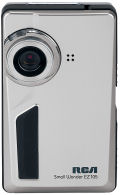 In contrast to powerful HD camcorders, the emphasis of the pocket-size
In contrast to powerful HD camcorders, the emphasis of the pocket-size  The good news for consumers is the end of the artificial megapixel wars. Instead, the new trends are really helpful developments in the image processing chips that assist with shooting better photos -- including stabilizing camera shake and enhancing focus and exposure with amazing technology like face recognition.
The good news for consumers is the end of the artificial megapixel wars. Instead, the new trends are really helpful developments in the image processing chips that assist with shooting better photos -- including stabilizing camera shake and enhancing focus and exposure with amazing technology like face recognition.
 After seeing the latest generation of digital cameras with cool features like image stabilization and face detection, I finally pulled the trigger and bought myself a new camera, the
After seeing the latest generation of digital cameras with cool features like image stabilization and face detection, I finally pulled the trigger and bought myself a new camera, the 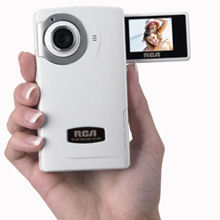 Here's the perfect wedding present of consumer electronics fun -- the new
Here's the perfect wedding present of consumer electronics fun -- the new  If you've ever found yourself stretching too far for a great shot over a crowd, or getting dirty trying to shoot a hard-to-reach area, then the
If you've ever found yourself stretching too far for a great shot over a crowd, or getting dirty trying to shoot a hard-to-reach area, then the  Fromm Works states that the Quik Pod is manufactured using high quality polycarbonate and aluminum components for strength and portability, and therefore can be used in all weather conditions, even for underwater photography in salt water.
Fromm Works states that the Quik Pod is manufactured using high quality polycarbonate and aluminum components for strength and portability, and therefore can be used in all weather conditions, even for underwater photography in salt water. Just look at these devices (like this Panasonic HDC-SD5), now available from companies including JVC, Panasonic, Samsung, and Sony. They're basically the size of a soda can -- a big lens, with a flip-out display on the side and some electronics and slots on the back for the battery and memory card. They're just so easy to carry and easy to use.
Just look at these devices (like this Panasonic HDC-SD5), now available from companies including JVC, Panasonic, Samsung, and Sony. They're basically the size of a soda can -- a big lens, with a flip-out display on the side and some electronics and slots on the back for the battery and memory card. They're just so easy to carry and easy to use. Actually, SD cards work just fine -- you now can fit an hour or more of video on an affordable SD card, so you can carry multiple hours of removable storage in the space previously used by one DV tape cassette. You can get a 4 GB SDHC card for around $50, and 8 GB SDHC cards are available from companies like Kingston and SanDisk for under $100.
Actually, SD cards work just fine -- you now can fit an hour or more of video on an affordable SD card, so you can carry multiple hours of removable storage in the space previously used by one DV tape cassette. You can get a 4 GB SDHC card for around $50, and 8 GB SDHC cards are available from companies like Kingston and SanDisk for under $100. Instead, try the
Instead, try the 
 If this approach appeals to you, check out the best of both worlds -- the
If this approach appeals to you, check out the best of both worlds -- the 
 Everything is included: they run on two ordinary AA batteries; operate with simple controls to record, review, and delete clips; connect to a PC with a built-in pop-out USB connector; and even include onboard software (for Windows and Mac) to edit and share your clips.
Everything is included: they run on two ordinary AA batteries; operate with simple controls to record, review, and delete clips; connect to a PC with a built-in pop-out USB connector; and even include onboard software (for Windows and Mac) to edit and share your clips.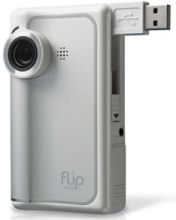 The Flip Video, released in May 2007, goes even simpler and smaller than the latest RCA Small Wonder design, by eliminating the flip-out viewfinder and memory card expansion slot.
The Flip Video, released in May 2007, goes even simpler and smaller than the latest RCA Small Wonder design, by eliminating the flip-out viewfinder and memory card expansion slot. And the newer Flip Video Ultra from September 2007 adds a no-glare viewfinder and beefs up the video quality (from 2.8 to 4.5 Mbps).
And the newer Flip Video Ultra from September 2007 adds a no-glare viewfinder and beefs up the video quality (from 2.8 to 4.5 Mbps). The
The  The
The 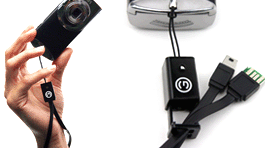 Another fun photo accessory is the
Another fun photo accessory is the 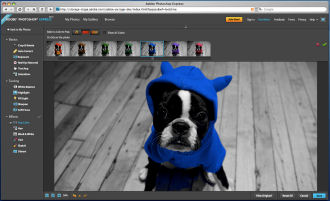


 A version of that design is now available in the U.S. as the
A version of that design is now available in the U.S. as the  Pure Digital has released a new version of its Flip Video line of portable and fun camcorders -- the
Pure Digital has released a new version of its Flip Video line of portable and fun camcorders -- the  Or to display your photos big and beautiful,
Or to display your photos big and beautiful,  The
The  And now the
And now the  I'm very impressed with the
I'm very impressed with the 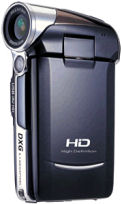 The
The  The
The  Check out his recent book,
Check out his recent book,  "Anyone can take pictures, but not everyone can make pictures," writes
"Anyone can take pictures, but not everyone can make pictures," writes  Meanwhile, Flip has introduced a new personalization option to
Meanwhile, Flip has introduced a new personalization option to  The
The  And the Gorillapod Go-Go is for smaller compact digital cameras, as well as supporting handheld devices including cell phones, PDAs, and music/video players, so you can watch them without having to hold them ($34).
And the Gorillapod Go-Go is for smaller compact digital cameras, as well as supporting handheld devices including cell phones, PDAs, and music/video players, so you can watch them without having to hold them ($34).
 But if the Mino was amazing, wait until you see the just-released Flip MinoHD -- It's the same design, the same functionality, but now it shoots HD video (720p), and is priced at $229.
But if the Mino was amazing, wait until you see the just-released Flip MinoHD -- It's the same design, the same functionality, but now it shoots HD video (720p), and is priced at $229.
 You can battle the elements, and take pictures of them at the same time, with the newly-announced
You can battle the elements, and take pictures of them at the same time, with the newly-announced  Panasonic offers two standard-definition models with not 20X, or 50X, but 70X optical zoom -- plus an optical image stabilization system to reduce hand-shake even at these extreme zooms. The SDR-S26 (shown here) is a small flash memory cam (SD card) for $329, in bright colors (another trend). The SDR-H80 and SDR-H90 are HDD models, with 60 and 80 GB, or up to 72 hours of recording (in LP mode), for $449 and $499.
Panasonic offers two standard-definition models with not 20X, or 50X, but 70X optical zoom -- plus an optical image stabilization system to reduce hand-shake even at these extreme zooms. The SDR-S26 (shown here) is a small flash memory cam (SD card) for $329, in bright colors (another trend). The SDR-H80 and SDR-H90 are HDD models, with 60 and 80 GB, or up to 72 hours of recording (in LP mode), for $449 and $499. For shooting in high-def, Panasonic has three new introductory high-def camcorders with different format combinations, the compact and lightweight HDC-SD20 with SD card for $599, the Twin Memory HDC-TM20 with SD card plus 16 GB built-in memory for $649, and the hybrid HDC-HS20 (shown here) with SD card plus 80 GB HDD for $999. These include a touch-screen display, an intelligent index system that detects scene changes and shooting adjustments to skip rapidly through recorded video, and 5-microphone surround sound audio.
For shooting in high-def, Panasonic has three new introductory high-def camcorders with different format combinations, the compact and lightweight HDC-SD20 with SD card for $599, the Twin Memory HDC-TM20 with SD card plus 16 GB built-in memory for $649, and the hybrid HDC-HS20 (shown here) with SD card plus 80 GB HDD for $999. These include a touch-screen display, an intelligent index system that detects scene changes and shooting adjustments to skip rapidly through recorded video, and 5-microphone surround sound audio. Then the more advanced, semi-pro HD camcorders add three full-HD MOS sensors, for over 9 megapixels of resolution. The compact HDC-HS250 and the HDC-HS300 with more manual controls have 120 GB HDD for $999 and $1,399, and the Twin Memory HDC-TM300 (shown here) has 32 GB of built-in memory for $1,299.
Then the more advanced, semi-pro HD camcorders add three full-HD MOS sensors, for over 9 megapixels of resolution. The compact HDC-HS250 and the HDC-HS300 with more manual controls have 120 GB HDD for $999 and $1,399, and the Twin Memory HDC-TM300 (shown here) has 32 GB of built-in memory for $1,299.  But now Sony has introduced its own Wi-Fi enabled camera, the
But now Sony has introduced its own Wi-Fi enabled camera, the  The magic behind this is
The magic behind this is  And Dell has just announced their version of this idea -- the
And Dell has just announced their version of this idea -- the  Of course, the obvious next step is to get back to the instant camera, which is exactly what Polaroid announced at the CES conference -- the new Polaroid PoGo Instant Digital Camera, a 5 megapixel camera with integrated instant printer. It has a 3" LCD display, SD slot for expanded memory, and is 4.7 x 3 inches and 10 ounces. It's due in March for $199.
Of course, the obvious next step is to get back to the instant camera, which is exactly what Polaroid announced at the CES conference -- the new Polaroid PoGo Instant Digital Camera, a 5 megapixel camera with integrated instant printer. It has a 3" LCD display, SD slot for expanded memory, and is 4.7 x 3 inches and 10 ounces. It's due in March for $199. In addition, the
In addition, the 

 David Pogue has done it again, with his modestly named
David Pogue has done it again, with his modestly named 
 Got pics in your pocket? You don't need to carry snapshots in your wallet anymore, much less a photo album in your bag -- That's so last decade!
Got pics in your pocket? You don't need to carry snapshots in your wallet anymore, much less a photo album in your bag -- That's so last decade!  The FlipShare software already provided simple video editing to make your own movies, and then share via e-mail and also by uploading directly to MySpace or YouTube. And Flip Video has just updated the FlipShare software to now share your videos through Flip Channels -- your own personal video collections shared on the web (at
The FlipShare software already provided simple video editing to make your own movies, and then share via e-mail and also by uploading directly to MySpace or YouTube. And Flip Video has just updated the FlipShare software to now share your videos through Flip Channels -- your own personal video collections shared on the web (at  Eye-Fi added video uploads in March, along with a 4 GB card and a free iPhone app (see
Eye-Fi added video uploads in March, along with a 4 GB card and a free iPhone app (see  In addition, DXG offers pairs of similar models in your choice of form factor: vertical (with the lens on the side and a flip-out display), and horizontal (like traditional camcorders).
In addition, DXG offers pairs of similar models in your choice of form factor: vertical (with the lens on the side and a flip-out display), and horizontal (like traditional camcorders).  The new DXG Luxe Collection, introduced this week, offers stylish designs to let you express your taste and personal style.
The new DXG Luxe Collection, introduced this week, offers stylish designs to let you express your taste and personal style.  Then for a more rugged design for active use, the DXG-125V All-Weather HD Camcorder is a splash and weather-resistant, with a rubber handgrip on the sides.
Then for a more rugged design for active use, the DXG-125V All-Weather HD Camcorder is a splash and weather-resistant, with a rubber handgrip on the sides.  For swimming, snorkeling, and diving, the DXG-579VS Underwater Value Pack combines the DXG-579V camera with an underwater casing that is waterproof up to 15 feet, to protect from water, salt, sand, and elements.
For swimming, snorkeling, and diving, the DXG-579VS Underwater Value Pack combines the DXG-579V camera with an underwater casing that is waterproof up to 15 feet, to protect from water, salt, sand, and elements.  For example, the
For example, the  The Samsung DualView TL220 / TL225 digital cameras have several modes to take advantage of the 1.5" front LCD:
The Samsung DualView TL220 / TL225 digital cameras have several modes to take advantage of the 1.5" front LCD: The connected Samsung CL65 digital camera is a similar size, with a 3.5" LCD and 5X optical zoom, and is priced at $399.
The connected Samsung CL65 digital camera is a similar size, with a 3.5" LCD and 5X optical zoom, and is priced at $399.  Pure Digital has had tremendous success with its
Pure Digital has had tremendous success with its  Which brings us to the new Flip MinoHD 120 minute model, just announced today. This doubles the recording time of the original Flip MinoHD 60 min. model, increases the screen size to 2 inches (matching the Ultra), and adds a HDMI connector so you can play videos directly on an HDTV.
Which brings us to the new Flip MinoHD 120 minute model, just announced today. This doubles the recording time of the original Flip MinoHD 60 min. model, increases the screen size to 2 inches (matching the Ultra), and adds a HDMI connector so you can play videos directly on an HDTV. But the focus at
But the focus at  But the new clever extension to the line is the Gorillatorch hands-free light, a bright LED light (maximum 65 lumens) with the now-familiar flexible legs, for $29. It is water resistant, and has a dimmer switch to control the light intensity and extend the battery life (from some 20 to 80 hours on 3 AAA batteries).
But the new clever extension to the line is the Gorillatorch hands-free light, a bright LED light (maximum 65 lumens) with the now-familiar flexible legs, for $29. It is water resistant, and has a dimmer switch to control the light intensity and extend the battery life (from some 20 to 80 hours on 3 AAA batteries). The current Lensbaby line offers three lens models, depending on the amount of hacking you like -- precise setup with the Lensbaby Composer, as the ball and socket design holds the position ($270), fast and loose with the Lensbaby Muse, as you manually set and hold the position ($100 / $150), or methodical with the Control Freak, which you set up, lock in, and then can further fine-tune both the focus and tilt.
The current Lensbaby line offers three lens models, depending on the amount of hacking you like -- precise setup with the Lensbaby Composer, as the ball and socket design holds the position ($270), fast and loose with the Lensbaby Muse, as you manually set and hold the position ($100 / $150), or methodical with the Control Freak, which you set up, lock in, and then can further fine-tune both the focus and tilt. The
The  The ability to download applications to smartphones has allowed Adobe to extend
The ability to download applications to smartphones has allowed Adobe to extend  But even better for on-the-go shooting instead is a small and simple device to help you steady your shots -- like the new
But even better for on-the-go shooting instead is a small and simple device to help you steady your shots -- like the new  For example, the RCA EZ209HD Small Wonder 720p HD Digital Camcorder for $129 / $89 street shoots up to 720p HD video in a slim design (~ 4.3 x 2.5 x 0.9 inches, 3 ounces) -- amazingly thin with a bump-out lens.
For example, the RCA EZ209HD Small Wonder 720p HD Digital Camcorder for $129 / $89 street shoots up to 720p HD video in a slim design (~ 4.3 x 2.5 x 0.9 inches, 3 ounces) -- amazingly thin with a bump-out lens. The
The 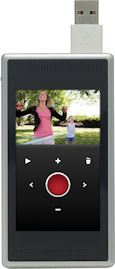 The new
The new  Then slide the display open, to pop up at a 45 degree angle for viewing your clips. Now the video fills the display, in full widescreen. There's a touch strip below to quickly flip through the stored clips, plus a menu button on the slide for settings, or (not too obviously) you can press and hold on the display to bring up play and volume controls.
Then slide the display open, to pop up at a 45 degree angle for viewing your clips. Now the video fills the display, in full widescreen. There's a touch strip below to quickly flip through the stored clips, plus a menu button on the slide for settings, or (not too obviously) you can press and hold on the display to bring up play and volume controls. The Flip line has two basic models, in addition to the SlideHD with slide-out widescreen display (see
The Flip line has two basic models, in addition to the SlideHD with slide-out widescreen display (see  The first goodie in the new Designed for Flip accessory program (see
The first goodie in the new Designed for Flip accessory program (see  And now there are
And now there are  The W3 is the successor to last year's Fujifilm W1, adding higher-res images, with video up to 720p (1280x720, 16:9 widescreen, at 24 fps), a larger widescreen 3.5” LCD, and Mini HDMI port for viewing directly in HD displays. The back display uses lenticular 3D technology, so you can view your images (and preview the shot) in 3D, with no glasses required.
The W3 is the successor to last year's Fujifilm W1, adding higher-res images, with video up to 720p (1280x720, 16:9 widescreen, at 24 fps), a larger widescreen 3.5” LCD, and Mini HDMI port for viewing directly in HD displays. The back display uses lenticular 3D technology, so you can view your images (and preview the shot) in 3D, with no glasses required. Even better, there's now a
Even better, there's now a  As a mirrorless electronic camera, the Alpha 9's technological advancements include:
As a mirrorless electronic camera, the Alpha 9's technological advancements include: The LX100 design approach uses a built-in lens to permit a more compact body. It's designed as a large sensor compact camera with a built-in lens.
The LX100 design approach uses a built-in lens to permit a more compact body. It's designed as a large sensor compact camera with a built-in lens. 